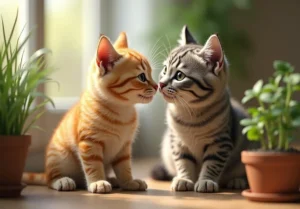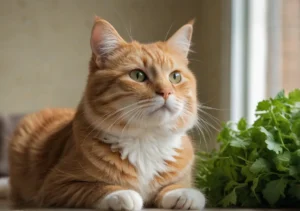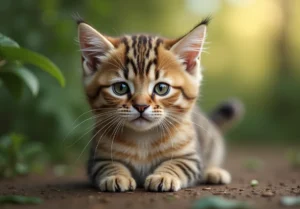Cats are notorious for their curious nature, often finding themselves drawn to the greenery of houseplants. But why exactly are cats so attracted to plants?
Cats and Houseplants: A Curious Attraction
Instinctual Behavior: Exploring the Root of the Attraction
Cats are known for their curious and inquisitive nature, which often leads them to explore the world around them. When it comes to plants, this behavior can be traced back to their instinctual roots as hunters. In the wild, cats may nibble on grass or other foliage to aid in digestion or to help eliminate fur balls. This behavior is thought to be a way for cats to regulate their digestive system and aid in passing any indigestible matter.
Moreover, cats are natural predators, and they may be drawn to plants as they resemble prey to them. The movement of leaves or the scent of certain plants may trigger their hunting instincts, causing them to paw at or nibble on the plant.
A Unique Insight:
Another reason why cats are attracted to plants could be related to their need for mental stimulation. Just like how toys can keep cats entertained and engaged, plants provide a new sensory experience for them to explore, keeping their minds active and engaged.
Nutritional Needs: Do Cats Crave Greens?
Contrary to popular belief, cats are obligate carnivores, meaning their diet primarily consists of meat. However, some experts suggest that cats may seek out plants to supplement their nutritional needs. Certain plants contain essential nutrients such as fiber, vitamins, and minerals that may be lacking in their diet.
While cats may not crave greens in the same way that herbivores do, they may instinctively seek out certain plants to fulfill specific dietary requirements. For example, cats that are deficient in certain vitamins or minerals may be more inclined to chew on plants that contain those nutrients.
So, while cats may not necessarily crave plants for their taste, their attraction to foliage could be a way for them to self-medicate or fulfill nutritional gaps in their diet. However, it’s essential to ensure that any plants accessible to your cat are safe for them to ingest, as some plants can be toxic and harmful to felines.
Scent Sensitivity: The Role of Smell in Plant Attraction
Cats have a keen sense of smell, much more sensitive than us humans. This heightened olfactory ability leads them to be attracted to the various scents emitted by plants. Cats have scent glands in their cheeks, paws, and other parts of their bodies, allowing them to mark their territory by rubbing against plants. So, when your kitty is sniffing around your precious houseplants, they’re likely drawn in by the enticing fragrances.
Moreover, some plants release pheromones or natural compounds that cats find irresistible. For instance, catnip contains a compound called nepetalactone, which can trigger a euphoric response in cats. So, when your furry friend is rolling around in that pot of catnip, it’s not just the pretty leaves they’re after, it’s the enticing smell too!
Texture Fascination: Why Cats Love to Paw at Plants
Aside from the alluring scents, cats are also captivated by the textures of plants. Felines have sensitive paws with numerous nerve endings, making them highly responsive to touch. This tactile sensitivity drives cats to explore different surfaces, including the leaves, stems, and soil of plants.
The varied textures of plants provide a sensory playground for cats. They may enjoy the softness of a fern frond, the roughness of a succulent, or the crunch of dried leaves. This fascination with textures explains why cats often paw at plants, kneading them or even chewing on the foliage.
Unique Insight: Cats may paw at plants not only for tactile stimulation but also to mimic natural behaviors like digging in soil. Providing a dedicated area with cat-friendly plants or a suitable digging box can help satisfy this instinctual urge and protect your houseplants from curious claws.
- Cats are intrigued by plants’ scents and textures, making them irresistible to our feline friends.
- Ensure your plants are safe for cats to explore, as some varieties can be toxic to pets.
- To deter cats from nibbling on plants, consider using natural deterrents like citrus scents or double-sided tape on plant pots.
Potential Dangers: Understanding the Risks of Plant Consumption
When it comes to understanding why cats are attracted to plants, it’s essential to recognize the potential dangers associated with their consumption. Cats are known for their curious nature, and sometimes this curiosity can lead them to nibble on plants, which can pose risks to their health.
One of the main dangers of plant consumption for cats is toxicity. Many common household plants are toxic to felines and can cause symptoms ranging from mild gastrointestinal upset to more severe issues like organ failure. Some plants that are particularly harmful to cats include lilies, azaleas, and philodendrons.
Ingesting plants can also lead to choking hazards or obstructions in a cat’s digestive system. Cats may not be able to fully digest plant material, leading to blockages that require veterinary intervention. Additionally, some plants have sharp edges or spines that can cause injuries to a cat’s mouth or throat.
To prevent these dangers, it’s crucial to be mindful of the plants you have in your home and ensure they are safe for your feline friend. Consider placing toxic plants out of reach or opting for plant alternatives that are non-toxic and appealing to your cat.
Plant Alternatives: Providing Safe Options for Your Feline Friend
When it comes to keeping your cat away from harmful plants, providing safe alternatives is key. Cats are naturally drawn to greenery, so offering cat-friendly plants can help satisfy their instinctual desire to chew on foliage without putting their health at risk.
Consider introducing catnip, cat grass, or cat mint to your feline companion’s environment. These plants are not only safe for cats but can also provide enrichment and stimulation for your pet. Cat grass, in particular, can aid in digestion and reduce hairballs in cats.
Another alternative to traditional plants is using interactive toys or puzzle feeders that simulate the experience of foraging for plants. These can keep your cat engaged and mentally stimulated while preventing them from munching on potentially harmful foliage.
By providing safe plant alternatives and enriching your cat’s environment in other ways, you can help satisfy their natural instincts while keeping them safe from the potential dangers of plant consumption.
Enrichment Activities: Using Plants to Stimulate Your Cat
Are you looking for ways to keep your feline friend entertained and engaged? Utilizing plants as enrichment tools can be a fantastic way to stimulate your cat’s natural instincts and provide mental and physical exercise.
1. Interactive Plants: Consider introducing interactive plants such as cat grass or catnip into your cat’s environment. These plants can provide sensory stimulation and play opportunities for your furry companion.
2. DIY Plant Toys: Get creative and make DIY plant toys for your cat to interact with. Simple items like dangling leaves or a grassy hiding spot can encourage your cat to explore and play.
3. Vertical Gardens: Create vertical gardens or shelves with cat-friendly plants for your feline to climb, explore, and bat at. This can mimic their natural instinct to climb trees and provide a safe and engaging environment.
4. Rotation of Plants: Rotate the plants in your home to keep things fresh and exciting for your cat. Introducing new scents and textures can stimulate their senses and prevent boredom.
By incorporating plants into your cat’s environment in a thoughtful and intentional way, you can enhance their quality of life and provide them with enriching experiences.
Cat-Proofing Your Plants: Tips for Keeping Foliage Safe and Secure
Is your cat a little too curious about your plant collection? It’s essential to cat-proof your plants to ensure your furry friend’s safety and prevent any unwanted interactions that could harm both your cat and your foliage.
1. Choose Pet-Safe Plants: Opt for non-toxic plants that are safe for cats to be around. Some popular options include spider plants, cat grass, and orchids. Be sure to research any plant before bringing it into your home.
2. Elevated Plant Stands: Consider placing your plants on elevated stands or shelves to keep them out of reach of your cat’s curious paws. This can prevent your cat from nibbling on leaves or digging in the soil.
3. Deterrent Sprays: Use pet-safe deterrent sprays on your plants to discourage your cat from showing too much interest. These sprays are specially formulated to be safe for both your cat and your plants.
4. Prune Carefully: Trim any overhanging leaves or branches that your cat may be tempted to play with. By keeping your plants well-maintained and tidy, you can reduce the risk of your cat getting into mischief.
By implementing these cat-proofing strategies, you can create a harmonious living space where your plants and your furry friend can coexist peacefully.
Alex, a passionate animal lover, has experience in training and understanding animal behavior. As a proud pet parent to two dogs and three cats, he founded AnimalReport.net to share insights from animal experts and expand his knowledge of the animal kingdom.




